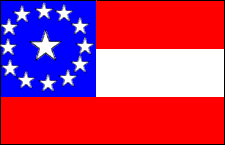Confederate Flags of the Old South History, Timeline & Pictures
Updated February 21, 2017 | Factmonster Staff 

A history of the different manifestations of the Confederate flag
| Introduction to the Confederate Flag Controversy . |
There is a common misperception that the Confederate battle flag (the "Southern Cross") was the national flag of the Confederacy. In reality, the flag we most associate with the Confederacy was strictly a battle flag—and not the only battle flag used. The Confederacy actually changed its national flag three times during the course of the war.
The First National Flag of the Confederacy—the "Stars and Bars"
March 1861 to May of 1863  The true "Stars and Bars" |
The original version of the Confederate national flag, called the Stars and Bars, included seven stars representing the first seven states to secede from the Union: South Carolina, Mississippi, Florida, Alabama, Georgia, Louisiana, and Texas. In its final form, the flag contained thirteen stars (adding the seceding states of Virginia, Arkansas, North Carolina, and Tennessee, as well as two states that attempted, but failed, to secede: Kentucky and Missouri). The flag's first official use was at the inauguration of Jefferson Davis on March 4, 1861. It was also used in combat, but its similarity to the Stars and Stripes caused confusion on the battlefield.
The Confederate Battle Flag—the "Southern Cross"
Sept. 1861-April 1865  The "Southern Cross" |
The best-known of all Confederate flags—the battle flag—is often erroneously confused with the national flag of the Confederacy. The battle flag features the cross of St. Andrew (the apostle was martyred by being crucified on an X-shaped cross), and is commonly called the "Southern Cross." A large degree of the Southern population was of Scottish and Scotch-Irish ancestry, and thus familiar with St. Andrew, the patron saint of Scotland. The stars represented the eleven states actually in the Confederacy, plus Kentucky and Missouri.
The Army of Northern Virginia was the first to design a flag with the cross of St. Andrew, and Gen. P. G. T. Beauregard proposed adopting a version of it as the standard battle flag of the Confederate army. One of its virtues was that, unlike the Stars and Bars, the Southern Cross was next to impossible to confuse with the Stars and Stripes in battle.
|
The Confederate battle flag eventually developed wide acceptance throughout the Confederacy, but it was by no means the only battle flag. The Stars and Bars continued to be used, and after it was replaced with a new national flag, that flag—the "Stainless Banner"—also appeared on the battlefield. In addition, some states used their own flags in combat.
It should also be pointed out that there was no uniform Southern Cross flag—throughout the South slightly different versions of the original design were adopted. Even their shape varied: some were square, the traditional shape of battle flags; others were rectangular. Because the South did not have the industrial resources of the North, the creation of flags was handled by a variety of cottage industries throughout the Confederacy, which contributed to the variations.
It should also be pointed out that there was no uniform Southern Cross flag—throughout the South slightly different versions of the original design were adopted. Even their shape varied: some were square, the traditional shape of battle flags; others were rectangular. Because the South did not have the industrial resources of the North, the creation of flags was handled by a variety of cottage industries throughout the Confederacy, which contributed to the variations.
The Second National Flag of the Confederacy-the "Stainless Banner"
May 1863-March 1865  The "Stainless Banner" |
On May 1, 1863, a new national flag was adopted, commonly known as the "Stainless Banner" because of its white field. The "Southern Cross" battle flag appeared in the canton on a white field. The flag's first official use was as the covering of Thomas J. "Stonewall" Jackson's casket. It too served as a battlefield flag. While the new flag avoided the problem of its predecessor—its similarity to the Stars and Stripes of the Union—it introduced its own form of confusion: largely white, it was thought it might be mistaken for a white flag of surrender.
The Third National Flag of the Confederacy
March 1865-April 1865  The third national Confederate flag. |
The final version of the Confederate flag was adopted just a month before the end of the Civil War. A wide band of red was added to the right side of the Stainless Banner design to distinguish the flag from one of surrender.
See also:
